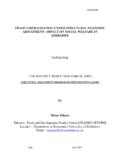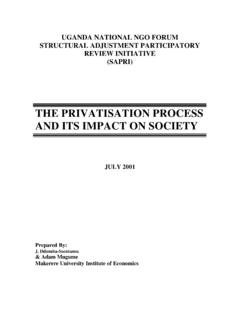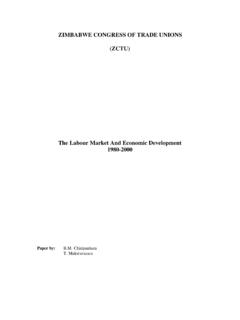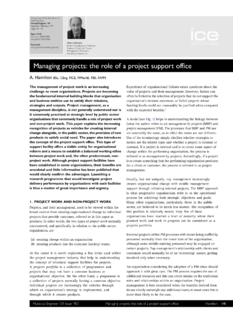Transcription of FINANCIAL SECTOR LIBERALIZATION AND THE …
1 0 FINANCIAL SECTOR LIBERALIZATION AND THE POOR: A CRITICAL APPRAISAL THERESA MOYO SAMCAF 5 THORNBURG AVENUE MT PLEASANT BOX MP 178 HARARE ZIMBABWE FOR THE SAPRI ZIMBABWE INITIATIVE POVERTY REDUCTION FORUM 1 1. Introduction The liberalisation of the FINANCIAL SECTOR in Zimbabwe was an integral part of the Economic structural adjustment Programme (ESAP), a programme which was introduced by the government in 1991. It was aimed at restructuring the economy from a predominantly state-interventionist type of economic management towards a more market-driven system.
2 The adoption of the ESAP and its successor programmes, namely the Zimbabwe Programme of Economic and Social Transformation (ZIMPREST) for the period 1996-2000, was a notable trend in most African countries where the failure of socialist experiments and other models of state management of the economy, led to a situation where countries had to resort to the World Bank and the International Monetary Fund (IMF) for FINANCIAL support. The structural adjustment Programme (SAP) is typically the prerequisite for assistance from those two multilateral bodies.
3 Prior to the introduction of the reforms, the SECTOR was very heavily controlled by the state. Interest rates were fixed by government, for example, lending rates to be charged by banks, deposit rates to savers, there were credit ceilings which channelled resources to specified sectors and there were restrictions as to who could carry out banking business. The SECTOR was heavily segmented, with categories of institutions being confined to specified types of banking business, for example, that building societies could only engage in mortgage finance, commercial banks to provide short term funding for working capital, merchant banks for wholesale banking etc.
4 It is now widely accepted that the structural adjustment model has not worked in Zimbabwe. The reasons for the failure are varied and also controversial. But this is not the focus of this paper. The argument presented here relates more to the component of FINANCIAL SECTOR liberalisation. Contrary to expectations, liberalisation of FINANCIAL markets has not improved access to credit by the poor and other marginalized groups. Indeed, there were a number of new entrants and players in response to the market signals of liberalised interest rates-both deposit and lending rates and the new opportunities to do business which resulted due to the opening up of the economy.
5 However, competition was not total, as the regulatory environment perpetuated segmentation and also made it particularly difficult for small players to enter the market and hence enhance their capacity to service the lower end of the market. Another reason for the general failure of FINANCIAL SECTOR liberalisation to improve the lot of the poor was the failure to harmonize monetary and fiscal policies. Persistently high budget deficits led to excessive borrowing by government, on the domestic market, and this made it difficult for interest rates to come down.
6 The paper argues fundamentally that in fact, FINANCIAL SECTOR liberalisation was not designed with poverty reduction as its thrust. The design and implementation of the programme make it quite evident that in fact, under the circumstances prevailing in Zimbabwe, they were unlikely to benefit the poor and the marginalised. The market by its nature benefits those who already have access to resources (economic), to information and to those who are strategically positioned to take advantage of the opportunities offered by the market (those already gainfully employed, those residing in urban areas, or in the few rural communities well networked to benefit from national and international trade.)
7 2 Overall, the paper argues whereas FINANCIAL SECTOR liberalisation in Zimbabwe did yield some benefits to some, in general, it did not really yield many positive results for most of the economically disadvantaged groups. A review of available literature showed that there is very little information available which could prove this point. And without extensive, systematic and structured field work (due to the paucity of resources on the part of the SAPRI programme), the conclusions made in the paper are largely based on inferences derived from analysis of for instance, published data from various bank reports and Reserve Bank of Zimbabwe (RBZ) publications.
8 Some of the conclusions are also based on the findings of the SAPRI workshops at district levels which were conducted in the early phases of the project. The experience of Zimbabwe with FINANCIAL SECTOR liberalisation points to the need to consciously establish FINANCIAL institutions and markets designed to service the economically active poor. These should be an integral part of the formal FINANCIAL system. It is worth noting that the emergence of the microfinance SECTOR in Zimbabwe coincides most closely with the introduction of reforms.
9 Microfinance has emerged as a response to the failure of the formal SECTOR to meet the needs of the SMEs and the informal SECTOR . Unfortunately, until very recently, the support to the microfinance SECTOR has been minimal and this has therefore compounded the problem of lack of access to credit and other FINANCIAL services. 2. Background To FINANCIAL SECTOR Reforms In classical thinking, banks are best able to perform the intermediary function within the context of a market system in which the supply and demand for credit rations credit among competing users.
10 Interest rates are determined through the interplay of market forces and become the instruments for resource allocation. And for as long as the market is allowed to operate, the finance SECTOR is able to play a positive role in fostering growth and economic development. Classical thought postulates that when the market is interfered with, then growth in inhibited. In the context of Zimbabwe, the failure of the finance SECTOR to perform as expected has been largely attributed to the problems of interference by the state through imposition of controls such as interest rate ceilings, selected credit controls and directed credit.










